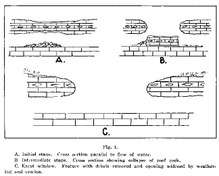Karst fenster
Karst fenster is a geomorphic feature formed from the dissolution of carbonate bedrock. In this feature, a spring emerges, then the discharge abruptly disappears into a sinkhole. The word fenster is German for 'window', as these features are windows into the karst landscape.
The term is used to denote an unroofed portion of a cavern which reveals part of a subterranean river[1]. A complex system of caves, known as karst topography, evolves from the effects of water erosion on carbonate rocks such as limestone, dolomite or gypsum. "A karst fenster is caused by a caving in of portions of the roof of a subterranean stream, thus making some of the underground stream visible from the surface"[2]. Theories in the creation of karst topography and karst fensters involve vadose water above the water table, and deep-circulating phreatic water (water in the zone of saturation) eroding away subsurface rock. Karst fensters may also form because of weathering from above.
An example of a karst fenster or window is Cedar Sink in Mammoth Cave National Park, Kentucky, USA.
Wm. von Osinski illustrated how karst windows develop by roof rock collapse. [3]

See also
- Karst – Topography formed from the dissolution of soluble rocks
References
-
- Easterbrook, Don J. Surface Processes and Landforms. Upper Saddle River, NJ: Prentice-Hall, Inc, 1999
-
- Ritter, Michael E. The Physical Environment: an Introduction to Physical Geography. 2006. Dec 2009.